Dual-Band Plasmonic Perfect Absorber Based on the Hybrid Halide Perovskite in the Communication Regime
Abstract
1. Introduction
2. Structure Design
3. Results and Discussion
4. Conclusions
Author Contributions
Funding
Data Availability Statement
Acknowledgments
Conflicts of Interest
References
- Geim, K.; Grigorieva, I.V. Van der Waals heterostructures. Nature 2013, 499, 419. [Google Scholar] [CrossRef] [PubMed]
- Cheng, Z.Q.; Li, Z.L.; Luo, X.; Shi, H.Q.; Luo, C.L.; Liu, Z.M.; Nan, F. Enhanced second harmonic generation by double plasmon resonances in mesoscale flower-like silver particles. Appl. Phys. Lett. 2019, 114, 011901. [Google Scholar] [CrossRef]
- Chen, K.; Adato, R.; Altug, H. Dual-band perfect absorber for multispectral plasmon-enhanced infrared spectroscopy. ACS Nano 2012, 6, 7998–8006. [Google Scholar] [CrossRef]
- Wang, Y.Y.; Chen, Z.Q.; Xu, D.Y.; Yi, Z.; Chen, X.F.; Chen, J.; Tang, Y.J.; Wu, P.H.; Li, G.F.; Yi, Y.G. Triple-band perfect metamaterial absorber with good operating angle polarization tolerance based on split ring arrays. Results Phys. 2020, 16, 102951. [Google Scholar] [CrossRef]
- Luo, X.; Liu, Z.M.; Cheng, Z.Q.; Liu, J.P.; Lin, Q.; Wang, L.L. Polarization-insensitive and wide-angle broadband absorption enhancement of molybdenum disulfide in the visible regime. Opt. Express 2018, 26, 33918. [Google Scholar] [CrossRef] [PubMed]
- Xu, L.; Huang, W.Q.; Hu, W.Y.; Yang, K.; Zhou, B.X.; Pan, A.L.; Huang, G.F. Two-dimensional MoS2-graphene-based multilayer van der Waals heterostructures: Enhanced charge transfer and optical absorption, and electric-field tunable Dirac point and band Gap. Chem. Mater. 2017, 29, 5504. [Google Scholar] [CrossRef]
- Li, J.K.; Chen, Z.Q.; Yang, H.; Yi, Z.; Chen, X.F.; Yao, W.T.; Duan, T.; Wu, P.H.; Li, G.F.; Yi, Y.G. Tunable broadband solar energy absorber based on monolayer transition metal dichalcogenides materials using au nanocubes. Nanomaterials 2020, 10, 257. [Google Scholar] [CrossRef] [PubMed]
- Xia, S.X.; Zhai, X.; Wang, L.L.; Wen, S.C. Plasmonically induced transparency in in-plane isotropic and anisotropic 2D materials. Opt. Express 2020, 28, 7980. [Google Scholar] [CrossRef]
- Luo, X.; Cheng, Z.Q.; Zhai, X.; Liu, Z.M.; Li, S.Q.; Liu, J.P.; Wang, L.L.; Lin, Q.; Zhou, Y.H. A tunable dual-band and polarization-insensitive coherent perfect absorber based on double-layers graphene hybrid waveguide. Nanoscale Res. Lett. 2019, 14, 337. [Google Scholar] [CrossRef]
- Xiao, S.; Wang, T.; Liu, T.; Zhou, C.; Jiang, X.; Zhang, J. Active metamaterials and metadevices: A review. J. Phys. D Appl. Phys. 2020, 53, 503002. [Google Scholar] [CrossRef]
- Xu, L.; Peng, B.J.; Luo, X.; Zhai, X.; Wang, L.L. A broadband and polarization-insensitive perfect absorber based on a van der Waals material in the mid-infrared regime. Results Phys. 2019, 15, 102687. [Google Scholar] [CrossRef]
- Li, Q.; Xu, L.; Luo, K.W.; Li, X.F.; Huang, W.Q.; Wang, L.L.; Yu, Y.B. Electric-field-induced widely tunable direct and indirect band gaps in hBN/MoS2 van der Waals heterostructures. J. Mater. Chem. C 2017, 5, 4426. [Google Scholar] [CrossRef]
- Lu, H.; Gong, Y.K.; Mao, D.; Gan, X.T.; Zhao, J.L. Strong plasmonic confinement and optical force in phosphorene pairs. Opt. Express 2017, 25, 5255. [Google Scholar] [CrossRef] [PubMed]
- Cai, Y.J.; Xu, K.D.; Feng, N.X.; Guo, R.R.; Lin, H.J.; Zhu, J.F. Anisotropic infrared plasmonic broadband absorber based on graphene-black phosphorus multilayers. Opt. Express 2019, 27, 3101. [Google Scholar] [CrossRef] [PubMed]
- Sutherland, R.; Sargent, E.H. Perovskite photonic sources. Nat. Photonics 2016, 10, 295. [Google Scholar] [CrossRef]
- Chen, S.T.; Roh, K.D.; Lee, J.H.; Chong, W.K.; Lu, Y.; Mathews, N.; Nurmikko, T.C.S.A. A photonic crystal laser from solution based organo-lead iodide perovskite thin films. ACS Nano 2016, 6, 3959. [Google Scholar] [CrossRef]
- Zhou, H.; Dong, X.; Jiang, M.M.; Zheng, W.H.; Sun, L.X.; Zhao, B.B.; Tang, B.; Pan, A.L.; Zhang, L. Single-mode lasing and 3D confinement from perovskite micro-cubic cavity. J. Mater. Chem. C 2018, 6, 11740. [Google Scholar] [CrossRef]
- Green, M.A.; Ho-Baillie, A.; Snaith, H.J. The emergence of perovskite solar cells. Nat. Photonics 2014, 8, 506. [Google Scholar] [CrossRef]
- Makarov, S.; Furasova, A.; Tiguntseva, E.; Hemmetter, A.; Berestennikov, A.; Pushkarev, A.; Zakhidov, A.; Kivshar, Y. Halide-perovskite resonant nanophotonics. Adv. Opt. Mater. 2019, 7, 1800784. [Google Scholar] [CrossRef]
- Stranks, S.D.; Eperon, G.E.; Grancini, G.; Menelaou, C.; Alcocer, M.J.P.; Leijtens, T.; Herz, L.M.; Petrozza, A.; Snaith, H.J. Electron-hole diffusion lengths exceeding 1 micrometer in an organometal trihalide perovskite absorber. Science 2013, 342, 341. [Google Scholar] [CrossRef]
- Dong, Q.; Fang, Y.; Shao, Y.; Mulligan, P.; Qiu, J.; Cao, L.; Huang, J. Solar cells. Electron-hole diffusion lengths >175 μm in solution-grown CH3NH3PbI3 single crystals. Science 2015, 347, 967. [Google Scholar] [CrossRef] [PubMed]
- Manser, J.S.; Christians, J.A.; Kamat, P.V. Intriguing optoelectronic properties of metal Halide Perovskites. Chem. Rev. 2016, 116, 12956. [Google Scholar] [CrossRef] [PubMed]
- Kojima, A.; Teshima, K.; Shirai, Y.; Miyasaka, T. Organometal Halide Perovskites as visible-light sensitizers for photovoltaic cells. J. Am. Chem. Soc. 2009, 131, 6050. [Google Scholar] [CrossRef] [PubMed]
- Kim, H.S.; Lee, C.R.; Im, J.H.; Lee, K.B.; Moehl, T.; Marchioro, A.; Moon, S.J.; Baker, R.H.; Yum, J.H.; Moser, J.E.; et al. Lead Iodide Perovskite sensitized all-solid-state submicron thin film mesoscopic solar cell with efficiency exceeding 9%. Sci. Rep. 2012, 2, 591. [Google Scholar] [CrossRef] [PubMed]
- Ball, J.M.; Lee, M.M.; Hey, A.; Snaith, H.J. Low-temperature processed meso-superstructured to thin-film perovskite solar cells. Energy Environ. Sci. 2013, 6, 1739. [Google Scholar] [CrossRef]
- Zhou, H.; Chen, Q.; Li, G.; Li, G.; Luo, S.; Song, T.B.; Duan, H.S.; Hong, Z.R.; You, J.B.; Liu, Y.S.; et al. Interface engineering of highly efficient perovskite solar cells. Science 2014, 345, 542. [Google Scholar] [CrossRef]
- Correa-Baena, J.P.; Abate, A.; Saliba, M.; Tress, W.; Jacobsson, T.J.; Gratzel, M.; Hagfeldt, A. The rapid evolution of highly efficient perovskite solar cells. Energy Environ. Sci. 2017, 10, 710. [Google Scholar] [CrossRef]
- Zhang, Y.P.; Lim, C.K.; Dai, Z.; Yu, G.; Haus, J.W.; Zhang, H.; Prasad, P.N. Photonics and optoelectronics using nano-structured hybrid perovskite media and their optical cavities. Phy. Rep. 2019, 795, 1. [Google Scholar] [CrossRef]
- Hao, J.; Zhou, L.; Qi, M. Nearly total absorption of light and heat generation by plasmonic metamaterials. Phys. Rev. B 2011, 83, 165107. [Google Scholar] [CrossRef]
- Moreau, A.; Ciraci, C.; Mock, J.; Hill, R.; Wang, Q.; Wiley, B.; Chilkoti, A.; Smith, D.R. Controlled-reflectance surfaces with film-coupled colloidal nanoantennas. Nature 2012, 492, 86. [Google Scholar] [CrossRef]
- Johnson, P.B.; Christy, R.W. Optical constants of the noble metals. Phys. Rev. B 1972, 6, 4370. [Google Scholar] [CrossRef]
- Ishii, T.; Sato, T. Growth of single crystals of hexagonal boron nitride. J. Cryst. Growth 1983, 61, 689. [Google Scholar] [CrossRef]
- Jackson, J.D. Classical Electrodynamics, 3rd ed; Wiley: Hobokennm, NJ, USA, 1999. [Google Scholar]
- Kresse, G.; Hafner, J. Ab initio molecular dynamics for liquid metals. Phys. Rev. B 1993, 47, 558. [Google Scholar] [CrossRef] [PubMed]
- Kresse, G.; Furthmuller, J. Efficient iterative schemes for ab initio total-energy calculations using a plane-wave basis set. Phys. Rev. B 1996, 54, 11169. [Google Scholar] [CrossRef]
- Grimme, S. Semiempirical GGA-type density functional constructed with a long-range dispersion correction. J. Comput. Chem. 2006, 27, 1787. [Google Scholar] [CrossRef]
- Shirayama, M.; Kadowaki, H.; Miyadera, T.; Sugita, T.; Tamakoshi, M.; Kato, M.; Fujiseki, T.; Murata, D.; Hara, S.; Murakami, T.N.; et al. Optical transitions in hybrid perovskite solar cells: Ellipsometry, density functional theory, and quantum efficiency analyses for CH3NH3PbI3. Phys. Rev. A 2016, 5, 014012. [Google Scholar] [CrossRef]
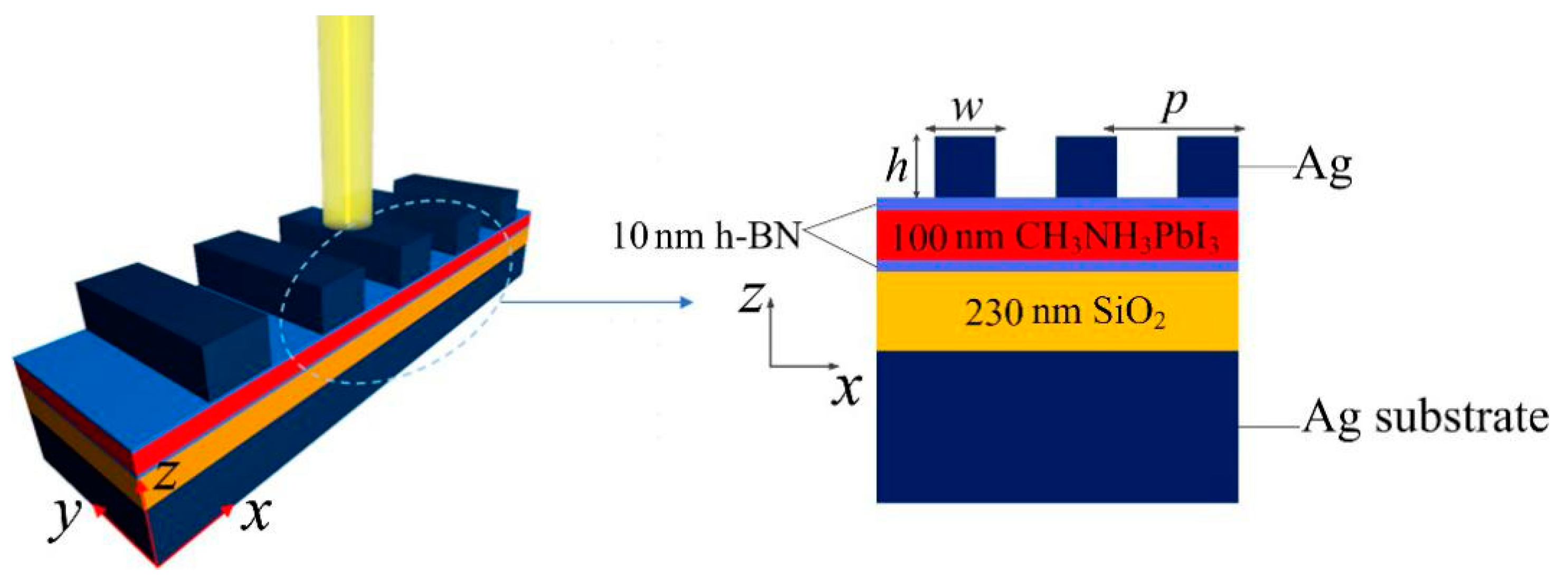
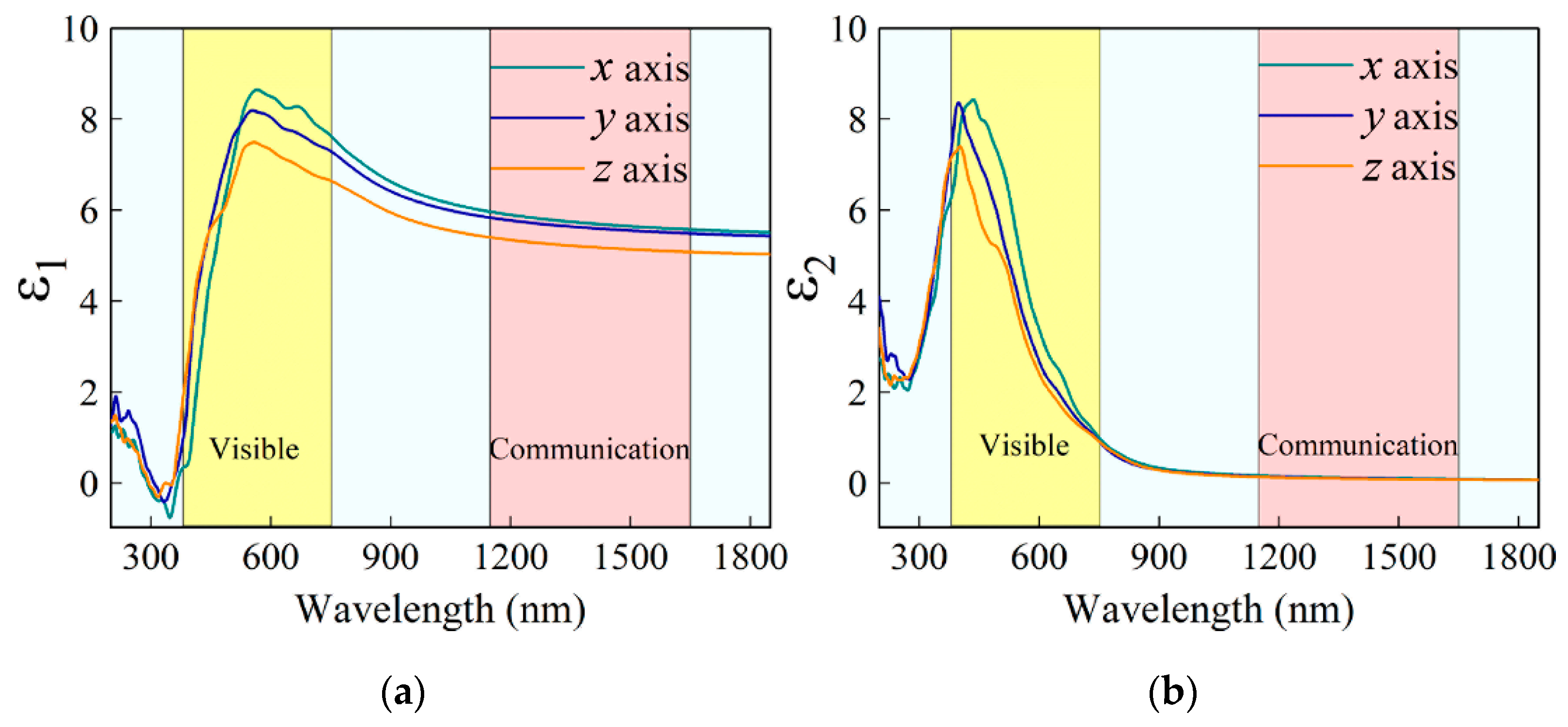

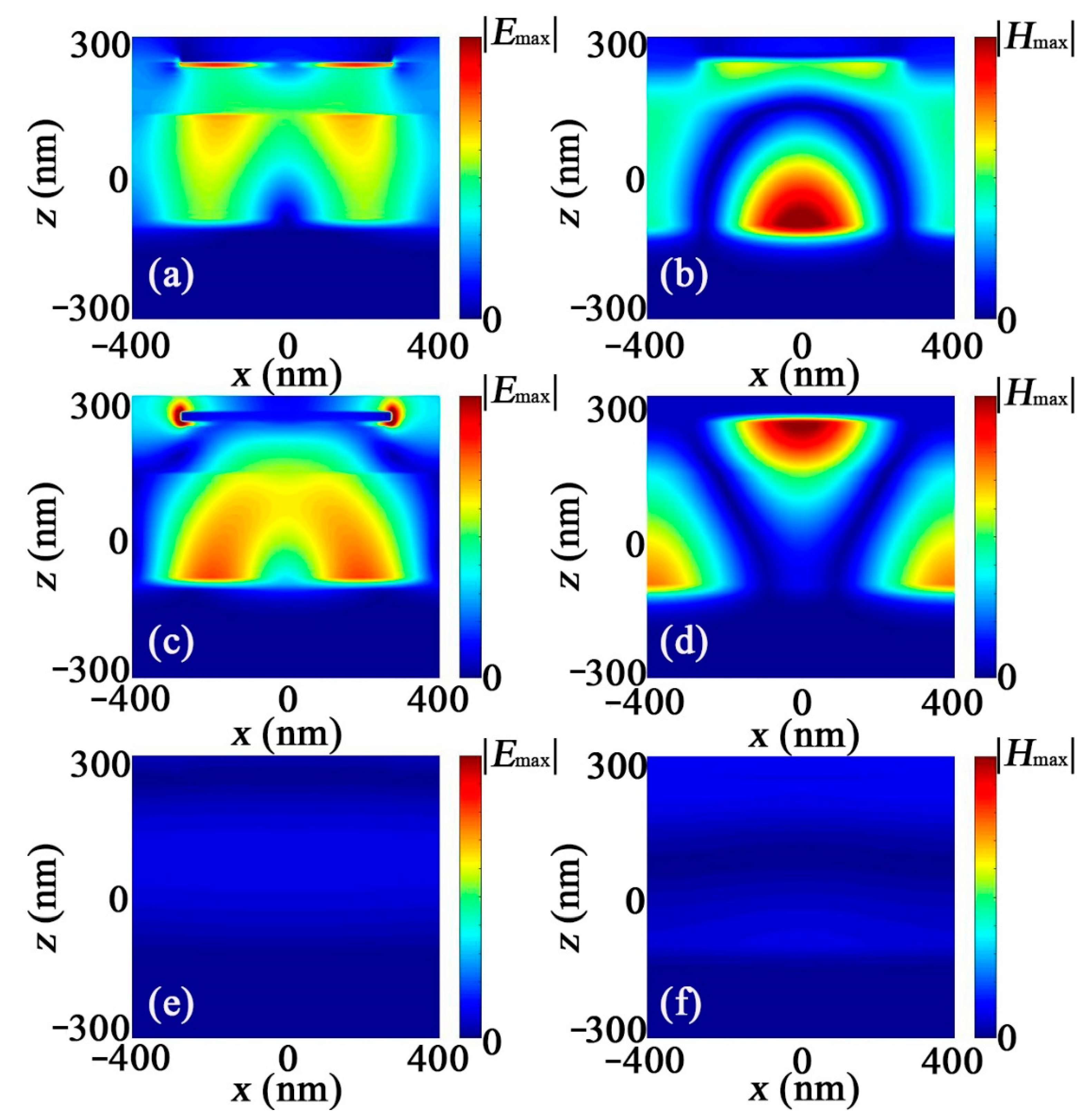
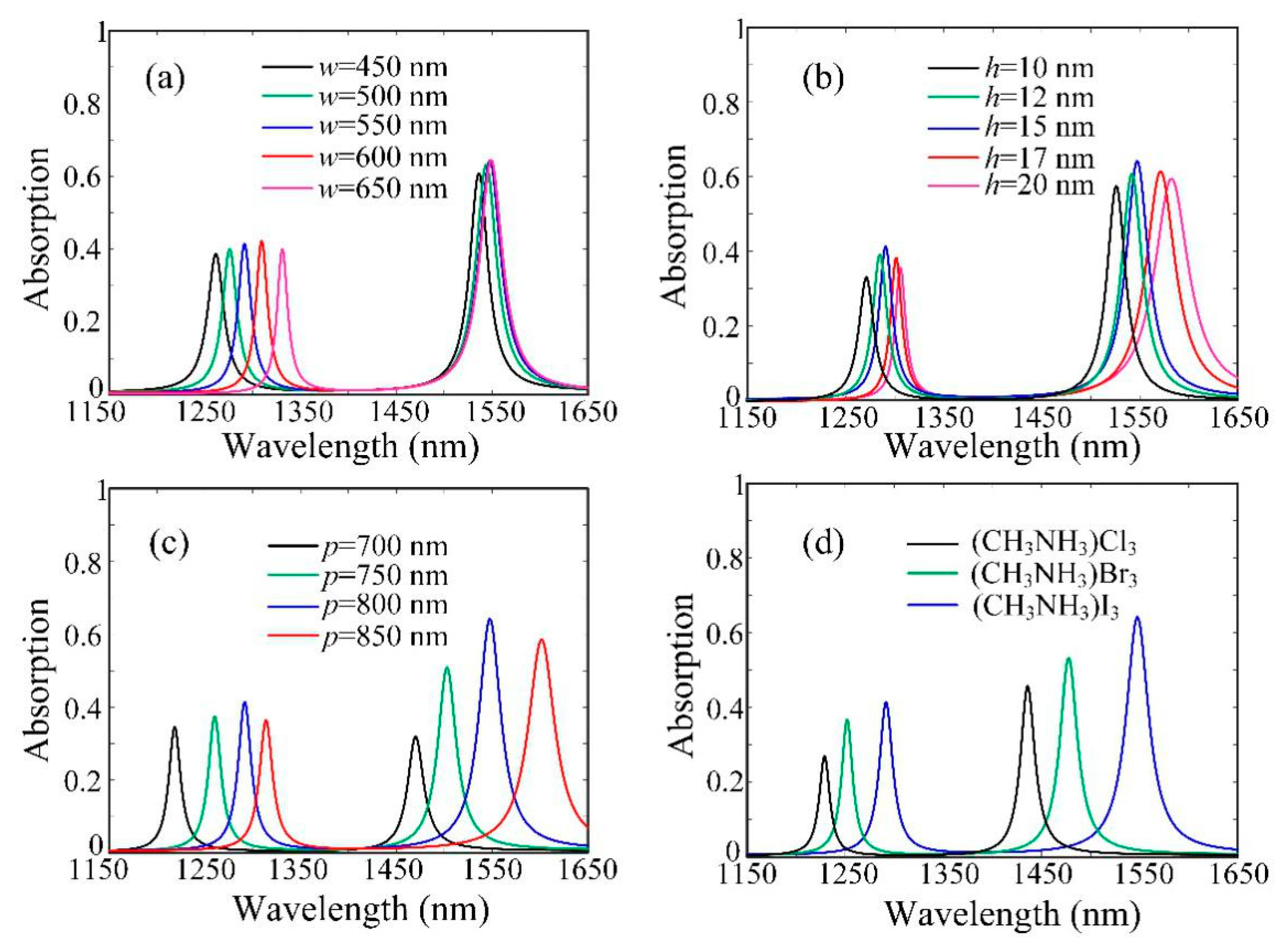
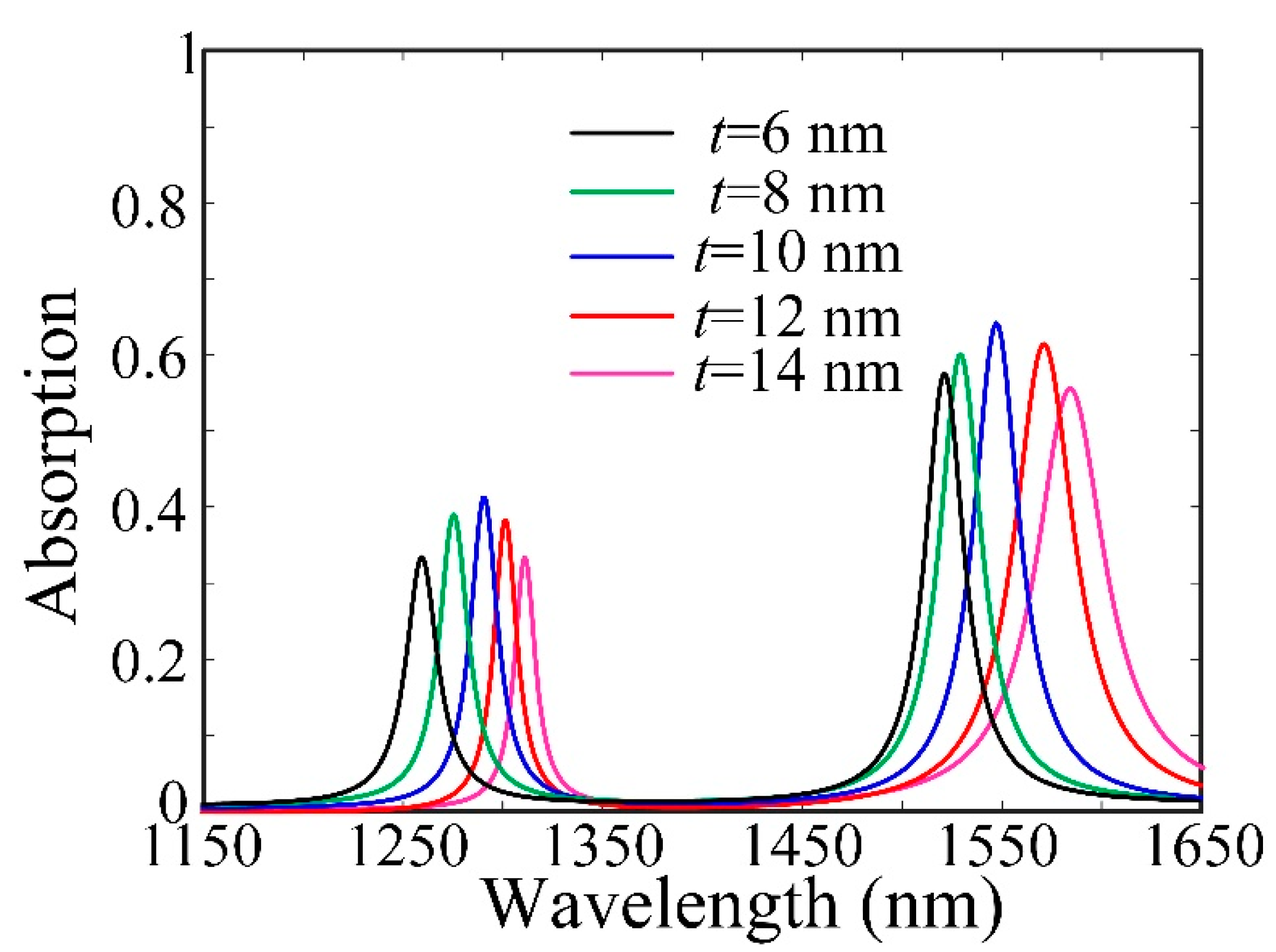
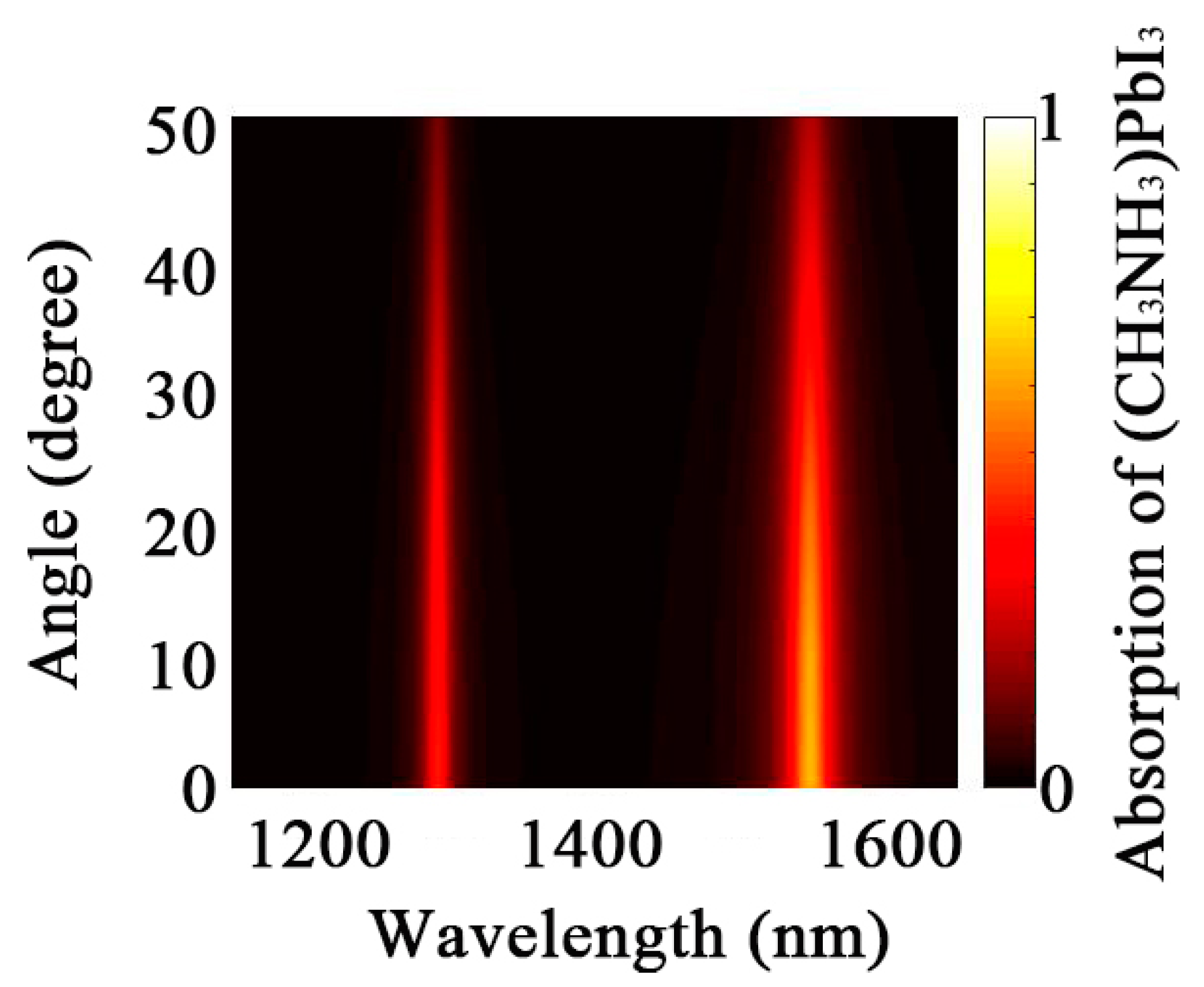
Publisher’s Note: MDPI stays neutral with regard to jurisdictional claims in published maps and institutional affiliations. |
© 2021 by the authors. Licensee MDPI, Basel, Switzerland. This article is an open access article distributed under the terms and conditions of the Creative Commons Attribution (CC BY) license (http://creativecommons.org/licenses/by/4.0/).
Share and Cite
Xu, L.; Zeng, J.; Luo, X.; Xia, L.; Ma, Z.; Peng, B.; Li, Z.; Zhai, X.; Wang, L. Dual-Band Plasmonic Perfect Absorber Based on the Hybrid Halide Perovskite in the Communication Regime. Coatings 2021, 11, 67. https://doi.org/10.3390/coatings11010067
Xu L, Zeng J, Luo X, Xia L, Ma Z, Peng B, Li Z, Zhai X, Wang L. Dual-Band Plasmonic Perfect Absorber Based on the Hybrid Halide Perovskite in the Communication Regime. Coatings. 2021; 11(1):67. https://doi.org/10.3390/coatings11010067
Chicago/Turabian StyleXu, Liang, Jian Zeng, Xin Luo, Libin Xia, Zongle Ma, Bojun Peng, Zhengquan Li, Xiang Zhai, and Lingling Wang. 2021. "Dual-Band Plasmonic Perfect Absorber Based on the Hybrid Halide Perovskite in the Communication Regime" Coatings 11, no. 1: 67. https://doi.org/10.3390/coatings11010067
APA StyleXu, L., Zeng, J., Luo, X., Xia, L., Ma, Z., Peng, B., Li, Z., Zhai, X., & Wang, L. (2021). Dual-Band Plasmonic Perfect Absorber Based on the Hybrid Halide Perovskite in the Communication Regime. Coatings, 11(1), 67. https://doi.org/10.3390/coatings11010067





